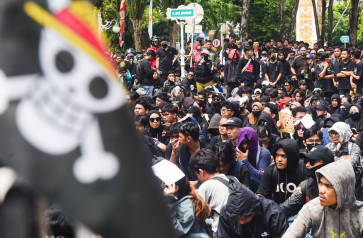Popular Reads
Top Results
Can't find what you're looking for?
View all search resultsPopular Reads
Top Results
Can't find what you're looking for?
View all search resultsFear is largest aftershock of Aceh quakes
The Meteorology, Climatology and Geophysics Agency (BMKG) says that more earthquakes might come following the huge 8
Change text size
Gift Premium Articles
to Anyone
T
he Meteorology, Climatology and Geophysics Agency (BMKG) says that more earthquakes might come following the huge 8.3-magnitude earthquake that struck off Aceh on Wednesday.
Suharjono, the seismologist in charge of the BMKG’s earthquake and tsunami division, said the agency was monitoring the after effects of the earthquake and its aftershocks on the movement of the tectonic plates under the archipelago.
“We’re keeping an eye on the movements of the plates to detect potential spots for an earthquake,” he said. “Indonesia is prone to natural disasters due its geographical position. The country’s position covers a number of tectonic plates.”
According to Suharjono, while earthquakes could occur at any time without notice, the BKMG could detect the presence of a tsunami within several minutes of an earthquake.
He said that tsunamis were more likely to occur if an earthquake’s epicenter was located near the junction of two tectonic plates.
“That was not the case today. The epicenter was in the western part of the plate and it only caused the plates to move vertically.”
The BMKG registered the first earthquake in Aceh on Wednesday at 3:38 p.m.
Indonesia is prone to earthquakes and volcanic eruptions as it is located within the so-called Pacific Ring of Fire at the junction of several tectonic plates.
Indonesia’s worst natural disaster was the 2004 Aceh earthquake and tsunami that killed more than 230,000 people along the Indian Ocean, including 170,000 people in Indonesia, prompting the largest evacuation and reconstruction efforts since World War II.
Tsunami expert Hamzah Latief from the West Java-based Bandung Institute of Technology (ITB) said that the earthquakes off Aceh on Wednesday were different from the monster temblor that struck in 2004, although they were all undersea earthquakes.
“The 2004 event was an undersea megathrust earthquake that caused a tsunami. But Wednesday’s incident was a horizontal displacement of a tectonic plate that triggered no drastic wave,” he said.
The BMKG reported that the sea level rose by only 80 centimeters in Meulaboh and by 20 centimeters in Sabang, Aceh.
While no destruction was reported after the earthquakes on Thursday, fears spread throughout nations all along the Indian Ocean, while markets in Thailand reeled.
As reported by Bloomberg, the rupiah fell to its lowest level in almost three weeks, while Thai stocks slumped.
The rupiah dropped 0.2 percent to Rp 9,205 per US dollar after strengthening 0.4 percent before the quake. It touched Rp 9,208, its weakest level since March 23.
Meanwhile Thailand’s benchmark SET Index sank 1 percent to a one-month low of 1,154.49.
Tin for delivery in three months in London gained 0.1 percent to US$22,773 a metric ton, after falling 1.5 percent, on speculation output from Indonesia, the world’s largest exporter, would be disrupted. (fzm/tas)
Natural disasters in Indonesia
Dec. 26, 2004 - More than 170,000 Indonesians were killed or listed as missing after a 9.1-Magnitude earthquake off Aceh triggers a tsunami. The death toll, including those killed in other countries along the Indian Ocean, topped 230,000.
March 28, 2005 - Magnitude-8.6 temblor off Sumatra’s west coast killed 1,300 people, mostly in Nias.
May 27, 2006 - Earthquake rocked Yogyakarta, killing 5,000 and destroying or damaging 150,000 homes.
July 17, 2006 - A tsunami following a magnitude-7.7 quake in West Java killed more than 500 and displaced 54,000.
March 6, 2007 - Two strong earthquakes killed 72 people and injured dozens in Padang, West Sumatra.
Sept. 2, 2009 - Magnitude-7.0 magnitude quake off of Java killed more than 60, displaced 25,000 and damaged 86,000 homes, although no major power or industrial installations are hit.
Sept. 30, 2009 - More than 1,100 died after a magnitude-7.6 quake rocked Padang, again. Thousands were trapped in the rubble of collapsed buildings.
Oct. 2010 - Mount Merapi near Yogyakarta began a months-long eruption, killing more than 130 people and
displacing 300,000, while a magnitude-7.5 off-shore quake triggered a tsunami that pounded Mentawai Islands, killing 445 people and flattened several villages and a surf resort.
Source: Reuters










